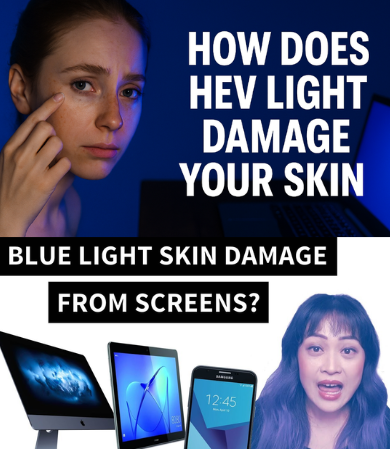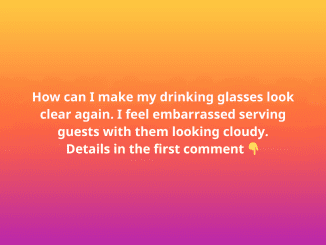
When you think of skin damage, your mind probably jumps straight to UVA and UVB rays. But there’s another culprit that most people overlook—HEV light, also known as blue light. Unlike traditional sun exposure, HEV light doesn’t just come from the sun. It beams at you all day long from your phone, computer, TV, and tablet screens. And while you may not feel an immediate burn like you do with UV rays, HEV light silently works beneath the surface, accelerating aging and leaving behind long-term damage.
Let’s explore how HEV light affects your skin, why it’s different from UVA and UVB, and most importantly, how you can protect yourself in a digital-first world.
What Exactly Is HEV Light?
HEV stands for High Energy Visible Light. It sits on the visible spectrum, with wavelengths between 380 and 500 nanometers, and it’s the part of the spectrum that appears as blue light. Unlike infrared or UV rays, you can actually see HEV light—it’s what gives the sky its blue color.
What makes it especially tricky is that HEV isn’t limited to sunlight. Every time you check your phone, scroll through social media, or work on your laptop, your skin is being exposed. Since we now spend hours glued to screens, HEV exposure is constant—day and night.
HEV Light vs. UVA and UVB Rays
We already know UVA and UVB rays are harmful. UVB is responsible for sunburn, while UVA penetrates deeper and accelerates skin aging. HEV light, however, goes beyond both.
- UVB rays: 280–320 nm, cause surface-level burns.
- UVA rays: 320–400 nm, penetrate deeper, leading to wrinkles and premature aging.
- HEV light: 380–500 nm, penetrates even deeper, creating free radicals and oxidative stress that damage skin cells around the clock.
Here’s the kicker: studies suggest the cumulative damage of HEV light can rival the effects of UVA and UVB combined. That means you’re not just dealing with outdoor sun exposure anymore—your indoor lifestyle is quietly sabotaging your skin health.
How HEV Light Damages Your Skin
The danger of HEV light lies in its ability to generate free radicals, also known as Reactive Oxygen Species (ROS). When ROS levels rise, they trigger a chain reaction inside your skin:
- Collagen and elastin fibers begin to break down, leading to sagging and fine lines.
- Skin cells weaken, losing their ability to repair themselves.
- Uneven pigmentation and dark spots develop, especially in people prone to melasma.
- Overall skin tone becomes dull, uneven, and tired-looking.
This process, called oxidative stress, is essentially your skin aging from the inside out. While UVA rays cause photoaging primarily during the day, HEV light is a 24/7 issue. Your screens don’t shut off when the sun goes down—so the damage continues even at night.
Video : Is Blue Light From Phones Hurting Your Skin? | Lab Muffin Beauty Science
Visible Effects of HEV Light on Skin
You may not notice the damage right away, but over time, blue light exposure shows up as:
- Fine lines and wrinkles forming earlier than expected
- Hyperpigmentation and stubborn dark spots
- Uneven tone and blotchy skin patches
- Loss of elasticity and firmness
- A tired, prematurely aged look
If you’ve ever wondered why your skin looks dull despite using sunscreen outdoors, HEV exposure could be the missing piece of the puzzle.
How to Protect Your Skin from HEV Light
So, how do you protect your skin when you can’t exactly toss out your phone or quit your job? Luckily, there are ways to minimize the damage without giving up your gadgets.
- Choose Sunscreen with HEV Protection
Most sunscreens focus on UVA and UVB protection, but some advanced formulas now defend against HEV light as well. Look for products that mention “blue light protection” or “broad-spectrum with HEV coverage.” - Incorporate Antioxidants
Topical antioxidants like Vitamin C, Vitamin E, and niacinamide help neutralize free radicals and strengthen your skin’s defense system. Eating antioxidant-rich foods such as berries, spinach, and nuts also helps combat oxidative stress. - Use Screen Filters or Apps
Blue light filters on your phone or computer reduce direct HEV exposure. Many devices now have built-in “night mode” settings that cut down on harsh blue light emissions. - Adopt a Skincare Routine that Repairs
Gentle cleansers, hydrating serums, and barrier-strengthening moisturizers should be staples in your skincare routine. Ingredients like hyaluronic acid and peptides can help restore what HEV light tries to take away. - Limit Screen Time When Possible
Taking breaks not only helps your eyes and mental health but also reduces prolonged HEV exposure. Even stepping away for 10 minutes every hour gives your skin a chance to recover.
The Role of Specialized Sunscreens
Not all sunscreens are created equal. Some new-generation formulations provide multi-layer protection—blocking UVA, UVB, infrared (IR), and HEV light. For example, SPF 50 sunscreens with PA+++ ratings often include advanced ingredients designed to reflect or absorb blue light before it penetrates your skin. If you’re already serious about anti-aging, switching to an HEV-protective sunscreen could be a game-changer.
Video : DOES BLUE LIGHT DAMAGE SKIN?? DR DRAY
Conclusion: Don’t Underestimate Blue Light
HEV light may not cause immediate burns like UVB rays or visible tanning like UVA, but its long-term effects are equally destructive—if not worse. Every swipe, scroll, and binge-watch session adds up, silently breaking down collagen, deepening wrinkles, and creating stubborn pigmentation.
The good news? Protecting your skin doesn’t require drastic lifestyle changes. By choosing the right sunscreen, loading up on antioxidants, and making smart screen-time adjustments, you can keep your skin youthful and resilient—even in a digital age.
Your devices aren’t going anywhere, but neither should your healthy glow. Take control today, and let your skin thank you tomorrow.


